
Getting Started
Inhalation Sedation Guide; Where to start dental:
Definition of Conscious Sedation:
“A Technique in which the use of a drug or drugs produces a state of depression of the central nervous system enabling treatment to be carried out.”
Ref: Standards in Conscious Sedation for Dentistry
October 2000
Report of an Expert Working Group
Where Do I Start?
- Training
- Site Preparation
- Equipment Choice
- Medical Gas Supply
- Scavenging
- Maintenance
Trending:
- Increased interest in use of inhalation sedation – possibly generated by scarcity of available dental GA's & rising patient waiting lists.
- Enhanced demand from ‘high street’, private and corporate practices – looking to increase level of patient choices to grow income.
- Growing demand for use of IHS in community dental for treating paediatric and special needs patients
- Despite IPC concerns, no significant shift towards use of digital sedation flowmeters – analogue models remaining equally popular.
Training Sources:
- NEBDN: Dental Sedation Nursing Syllabus
- SAAD: National Course in Sedation for Dentists & Dental Nurses
- Dental Hospitals: follow the NEBDN Syllabus
- Deaneries: Training and Study Days
- Ongoing CPD: various elements
- Private Trainers
Site Preparation:
When a requirement for ihs has been identified then the following should be considered:
- Suitable Premises/Surgeries – quantity
- Type of inhalation sedation flowmeter – Analogue or Digital
- Mounting Option
- Medical Gas Supply - Piped or Stand-alone
- Scavenging - breathing system/method of active draw
- Infection Control considerations
Site Preparation:
Areas to consider when in planning stage:
- How many surgeries to be used for inhalation sedation?
- Multiple rooms may indicate need for a piped system – mobile stand-alone can be still used if all surgeries on same floor
- Pre-planning vital to ensure all requirement adequately met
i.e. allowance for scavenging venting and cylinder storage
- Cabinetry design essential to accommodate equipment recommended a 500mm wide cabinet to accommodate, (300mm minimum - depending on mounting option chosen). For example, a swing arm bracket mounted pipeline fed MDM and Miniscav with an internally sliding door requires a 500mm minimum aperture.
Equipment Choice:
- Dedicated Sedation Flowmeter – Analogue or Digital
- Mounting – Dependant on medical gas supply – i.e. mobile 4 cylinder stand (stand-alone system) or bracket (pipeline supplied)
- Alternative Mounting – low/high stand (no yoke assembly) used with longer length pipeline hoses
- Choices with Scavenging - breathing systems/masks including IPC considerations
Inhalation Sedation Equipment Overview:
Manufacturer: Porter Instruments Inc
Matrx Analogue MDM (Formerly referred to as Quantiflex)
This analogue sedation flowmeter, first developed in the 1960’s, remains the most popular and widely used model in the U.K. today. As a purpose designed unit it has the following features: oxygen/nitrous oxide glass flowtubes, in-ratio oxygen failsafe, oxygen flush, air intake valve, non-rebreathing check valve, mixture percentage dial and total flow control knob with auto-compensation. Models are standard ISO with DISS fittings (Diameter Indexed Safety System) to prevent cross connection of medical gas hoses. Minimum 30% oxygen and maximum 70% nitrous oxide delivery.
Flowmeter Dimensions: (HxWxD) 8 ½” x 5” x 11” Weight 2.9 Kg.
The flowmeter can be mounted on a mobile four cylinder stand to be used as a ‘stand-alone’ system or pipeline mounted. The flowmeter is then bracket or low/high stand mounted with low pressure, colour coded (white – oxygen/blue – nitrous oxide) medical gas hoses. The hose length for bracket mounted models is one metre. Low/high stand mounting is typically 2-3 metres length to allow for positioning during use. The hose assemblies terminate in DISS fittings at the rear of the flowmeter and B.S. Probes to interface with the gas specific medical gas terminals.
The MDM flowmeter is robust, only usually requiring an annual O.E.M. maintenance to give reliable service and capable of lasting up to twenty years in use (Porter does not recommend support of this type of flowmeter for longer than that period).. There are some modern concerns with regard to infection control, but various methods of dealing with this are available, depending on preference of the user.

Matrx Digital MDM
Matrx have produced various electronic flowmeters, starting with the Centurion in the 1980’s (no longer in production). The current Digital MDM has not proved as popular as the Analogue MDM. The unit is also auto-compensating with a flat touch screen and LCD. The flowmeter also has audible and visual oxygen failure alarms. In addition, there is an auxiliary oxygen port to allow for connection of a demand valve resuscitator. Minimum 30 % oxygen and maximum 70% nitrous oxide. Models are standard ISO with DISS fittings.
Flowmeter Dimensions: (HxWxD) 4 ½” x 8” x 10 ½” Weight 2.6 Kg
This model can also be mounted on 4 cylinder stands, or pipeline mounted. One of the benefits of this unit is the infection control – a barrier shield can be used on the flat touch screen. However, these screens are also prone to damage from sharp items – including fingernails.
It also requires annual O.E.M. maintenance but has a shorter period of use – normally around 10-12 years.

Porter C3000 MXR R A Flowmeter
The C3000 is the smallest dedicated sedation flowmeter available. White bodied with dual seal failsafe, emergency air-intake and 100% oxygen flush. It does not auto-compensate.
This flowmeter was specifically designed with infection control in mind. The perspex cover can be removed to wipe behind (this cannot be done with the MDM). The stainless steel flow and mixture knobs can be removed and autoclaved. Minimum 30% oxygen and maximum 70% nitrous oxide.
This flowmeter can be a mobile 4 cylinder stand or bracket, high/low stand mounted.
Flowmeter dimensions: (HxWxD) 9” x 5” x 7 ½” Weight 2.6 Kg
The MXR is a reliable model, capable of offering up to twenty years’ service with regular annual O.E.M. maintenance.
These three flowmeters are manufactured by Porter Instruments, based in Hatfield, Philadelphia. They also manufacture the following mounting range:

Mobile 4 cylinder Stand (Universal PMP)
This unit has a yoke assembly mounted on a 26” tall column terminating in a 5 leg base for stability. Each castor has a brake. The yoke assembly allows connection of E size cylinders – oxygen & nitrous oxide using a pin-index system to prevent accidental crossing of medical gases. There are two oxygen ports and two nitrous oxide allowing during use; an ‘in-use’ cylinder and reserve ‘full’ cylinder. Between the two gas specific ports, there is a valve to prevent full cylinders decanting into empty ones if both cylinders are turned on together (which is not recommended).
The cylinders sit within a yoke gate and each medical gas is clearly identified. The stand has cylinder restraints to prevent excessive movement of the cylinders when the stand is being moved. This is to prevent damage or breaking of the pins. A bodok seal is also in place around the pin index location and this is to form a gas tight seal between the port and the cylinder valve. It is vital that a seal is in place otherwise an escape of gases can be detected. These seals often adhere to the cylinder valve and can be ‘lost’ when the cylinder is replaced.
A further, recent issue is the use of disinfecting hand gel which, like hand cream, can interact with the oxygen to cause a minor explosion. Dental staff are requested only to change cylinders with clean, recently washed hands.
Maximum height of an MDM and mobile 4 cylinder stand; 53” maximum and 40” minimum (the MDM flowmeter height can be adjusted up/down to suit)
Stand Dimensions (HxLxW) 93cm-114cm x 53.5cm x 53.5cm. Weight 11.2 Kg
These mobile cylinder stands are very popular in the U.K. The slight drawback is the quantity of medical gases in E cylinders – 680 gaseous litres for oxygen and 1800 gaseous litres for nitrous oxide, meaning that oxygen cylinders require changing quite frequently.

Flowmeter Mountings – various
Swing Arm Bracket – telescoping arm extending 15”. Requires a bottom mounting peg to interface with the MDM or DMDM. Used with pipeline hoses.
Low Mobile Stand – 5 leg base measuring 20” x 20”. Short column with no yoke assembly attached. Used with pipeline hoses.
Dimensions (column only): 16” – 24” Weight 3.2 Kg
5 leg base dimensions (HxWxD) 5” x 21” x 21” Weight 2.1 Kg
High Mobile Stand – 5 leg base measuring 20” x 20”. Longer column with no yoke assembly attached. Used with pipeline hoses.
Dimensions (column only): 29” x 37” Weight 3.8 Kg
5 leg base Dimensions (HxWxD) 5” x 21” x 21” Weight 2.1 Kg

Manufacturer: Accutron Inc
Ultra PC™ % Flowmeter
A white bodied analogue model with single-knob total flow control, nitrous oxide ratio control with oxygen fail-safe. Oxygen Flush 100% L/min. Emergency air valve, Directional check valve and oxygen resuscitator connection. Standard ISO model with DISS Fittings. Minimum 30% oxygen and maximum 70% nitrous oxide.
This flowmeter can be mobile 4 cylinder stand or bracket, high/low stand mounted.
Oxygen Flow range: 1-10 L/min
Nitrous Oxide Flow range: 0-7 L/min
Flowmeter dimensions (WxHxD) 11cm x 27cm x 20cm. Weight 2 Kg.
This flowmeter is usually reliable with annual O.E.M. maintenance and will last 10-20 years.

Digital Ultra Flowmeter™
This digital unit is proving very popular – most probably from the infection control viewpoint. It has dual digital and analogue flow indication for each gas. Audible & visual warning alarms.
Oxygen fail-safe, directional check valve, emergency air intake and oxygen flush with an oxygen resuscitator connection. The flat screen can be used with a barrier shield for infection control purposes.
Minimum 30% oxygen and maximum 70% nitrous oxide. Models are standard
ISO with DISS fittings.
Oxygen Flow range: 1.0 – 9.9 L/min
Nitrous Oxide Flow range: 0-0.6.9 L/min
Flowmeter dimensions (WxHxD) 7 ½” x 7” x 11” Weight 6.3 lbs.
This flowmeter has been available since 2017 and to date is proving very reliable. It is constructed from a solid metal case and therefore robust. Our estimation is that this unit, with regular O.E.M. maintenance will give 10 year + service and quite possibly much longer, which is excellent for a digital model.
Mounting options vary slightly with this unit – some Digital Ultra models can only be mounted on a mobile 4 cylinder stand. Flexmount models can be mounted by various options; brackets, including bi-fold wall arms and telescoping, high/low stands.

Newport Flowmeter system™
This unit has all of the operating features of the Ultra PC™ flowmeter, but its four cylinders (E) are enclosed in a metal cabinet. Its maximum height is 31 ¾” x 24” D x 19 ¼” H.
Despite the fact that the medical gas cylinders are enclosed and therefore hidden from view, it has some caveats. Dental staff have found it difficult to change the cylinders as each cylinder is not attached to a yoke as on the 4 cylinder stand but sits in the cabinet with its own pressure reducing regulator. This can make maintenance expensive as the regulators and hoses need changing every six years – and there are four, compared to two on a mobile 4 cylinder stand!
These three flowmeters are manufactured by Accutron Inc, Inc based in Phoenix, Arizona. They also manufacture the following mounting range:

Mobile 4 cylinder stand – top mounting
The Accutron mobile 4 cylinder stand is very similar in operation to the Porter PMP stand with a tall column supported by a 5 leg base and cylinder restraints.
There are a few cosmetic appearance differences, but the main functionality remains the same with a yoke assembly accepting four cylinders; two E oxygen and two E nitrous oxide.
Dimensions with an Ultra PC™ flowmeter attached:
Minimum height 31 3/8” x Maximum height 41 3/8”.
Dimensions with a Digital Ultra™ flowmeter attached: 36 ⅜”
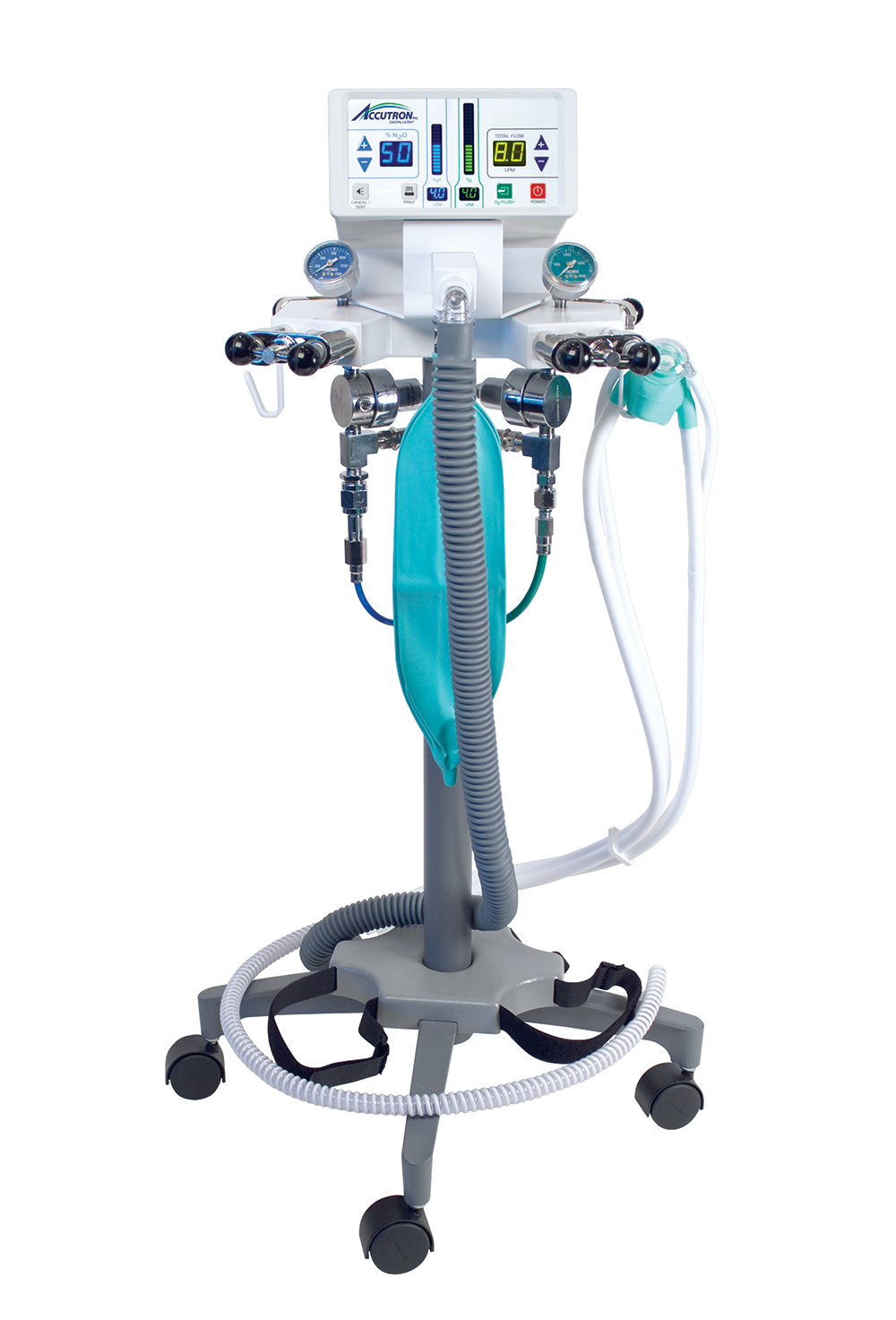
Mobile 4 cylinder stand – S bracket
This mobile 4 cylinder stand type is fit with an S bracket – allowing the flowmeter to be mounted forwards and to the front of the yoke assembly resulting in a lower and less obtrusive profile.
This type of S bracket fitting is only available on a 4 cylinder stand from Accutron and will not accept the Digital Ultra™ - only the Ultra PC™.
Flowmeter Mounting – various
Telescoping Wall Arm – Extends 12” - 17”
White powder coated finish. Mounts both Ultra PC™ and Digital Ultra™ Flexmount Flowmeters
Bi-Fold Wall Arm – Extends to 16”
White powder coated finish. Mounts both Ultra PC™ and Digital Ultra™ Flexmount Flowmeters
High Mobile Stand – Stand with no yoke assembly (used with pipeline hoses).
4 leg base. Height with Ultra Pc™ flowmeter 39 ¼”.
Can also be used to mount Digital Ultra™ Flexmount flowmeter.
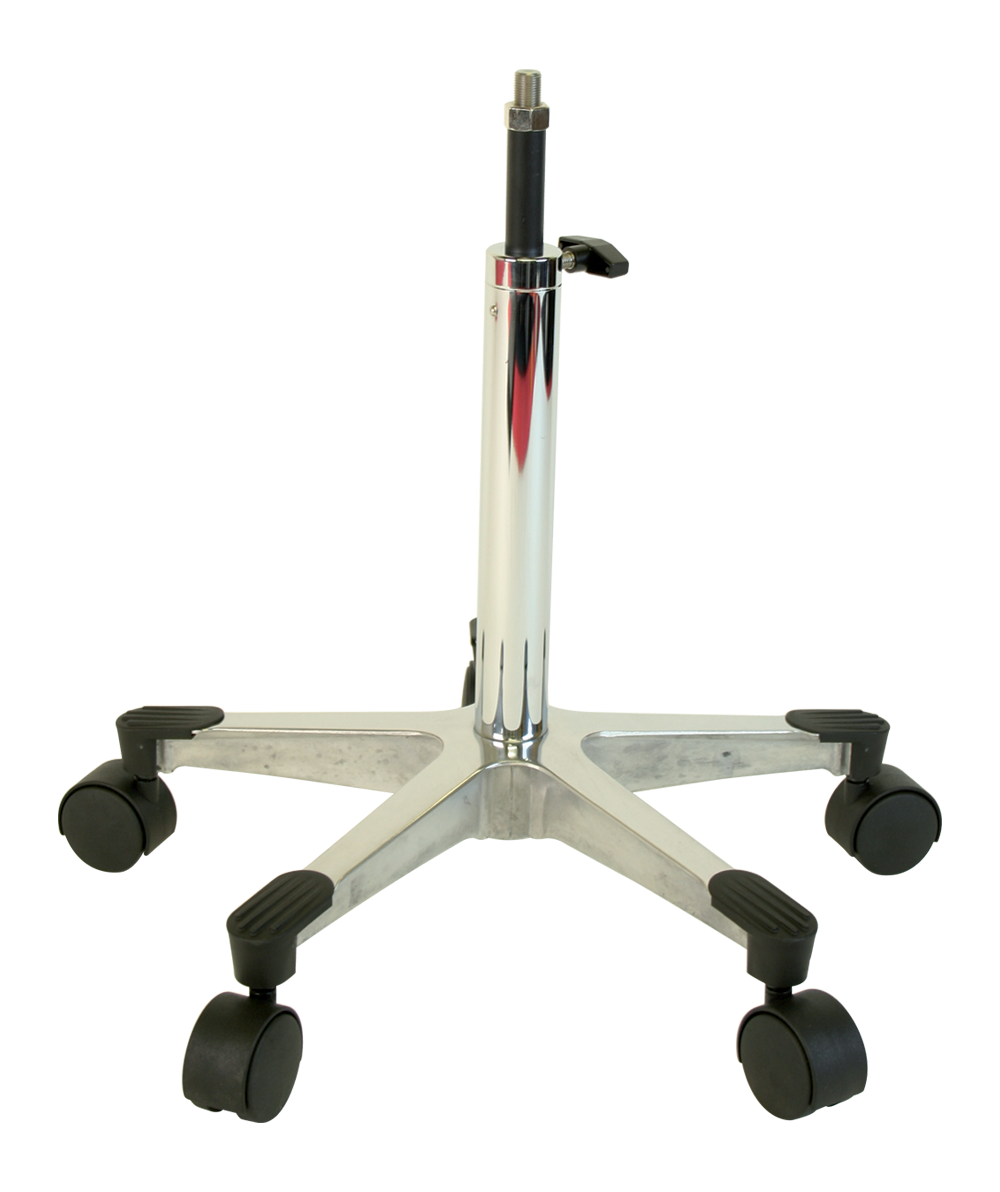
Low Mobile Stand (used with pipeline system)

Telescoping Wall Arm Bracket (used with pipeline system) Type may vary slightly depending on the unit to be mounted.
Medical Gas Supply:
This digital unit is proving very popular – most probably from the infection control viewpoint. It has dual digital and analogue flow indication for each gas. Audible & visual warning alarms.
Oxygen fail-safe, directional check valve, emergency air intake and oxygen flush with an oxygen resuscitator connection. The flat screen can be used with a barrier shield for infection control purposes.
Minimum 30% oxygen and maximum 70% nitrous oxide. Models are standard
ISO with DISS fittings.
Oxygen Flow range: 1.0 – 9.9 L/min
Nitrous Oxide Flow range: 0-0.6.9 L/min
Flowmeter dimensions (WxHxD) 7 ½” x 7” x 11” Weight 6.3 lbs.
This flowmeter has been available since 2017 and to date is proving very reliable. It is constructed from a solid metal case and therefore robust. Our estimation is that this unit, with regular O.E.M. maintenance will give 10 year + service and quite possibly much longer, which is excellent for a digital model.
Mounting options vary slightly with this unit – some Digital Ultra models can only be mounted on a mobile 4 cylinder stand. Flexmount models can be mounted by various options; brackets, including bi-fold wall arms and telescoping, high/low stands.

Medical Gas Supply:
This digital unit is proving very popular – most probably from the infection control viewpoint. It has dual digital and analogue flow indication for each gas. Audible & visual warning alarms.
Oxygen fail-safe, directional check valve, emergency air intake and oxygen flush with an oxygen resuscitator connection. The flat screen can be used with a barrier shield for infection control purposes.
Minimum 30% oxygen and maximum 70% nitrous oxide. Models are standard
ISO with DISS fittings.
Oxygen Flow range: 1.0 – 9.9 L/min
Nitrous Oxide Flow range: 0-0.6.9 L/min
Flowmeter dimensions (WxHxD) 7 ½” x 7” x 11” Weight 6.3 lbs.
This flowmeter has been available since 2017 and to date is proving very reliable. It is constructed from a solid metal case and therefore robust. Our estimation is that this unit, with regular O.E.M. maintenance will give 10 year + service and quite possibly much longer, which is excellent for a digital model.
Mounting options vary slightly with this unit – some Digital Ultra models can only be mounted on a mobile 4 cylinder stand. Flexmount models can be mounted by various options; brackets, including bi-fold wall arms and telescoping, high/low stands.

Scavenging:
- Must be compliant to COSHH and HTM 02-01
- Scavenging should be ‘Active’ – definition of which is ‘An air flow rate at the nasal mask of 40-45 L/min’ See HTM 02-01 Chapter 10 and Appendix L.
- Divided into two sections: Breathing System/Mask and Method of Active Draw for HTM 02-01 compliance.
Breathing Systems:
Reasonable variety available and choice is subject to individual preference.
- Most popular remains the Porter brown double mask system – used either with the Porter autoclavable mask or the Clearview coloured/scented single patient use mask.
- New systems starting to gain in popularity i.e. the Porter Silhouette & Accutron Axess
- Mix and match with available disposable elements

Porter brown scavenger breathing system with autoclavable double mask
manufactured by Porter Instruments Inc.

Porter brown Liners
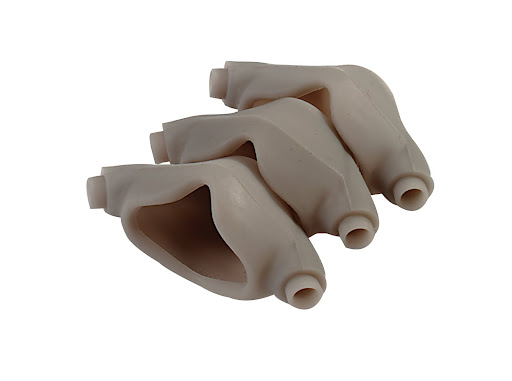
Grey Autoclavable

Green/White Single Patient Use only
Accutron breathing systems:
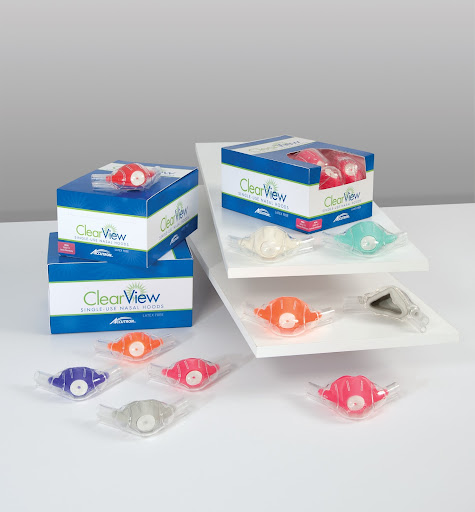

Newer types of breathing systems – Porter Silhouette


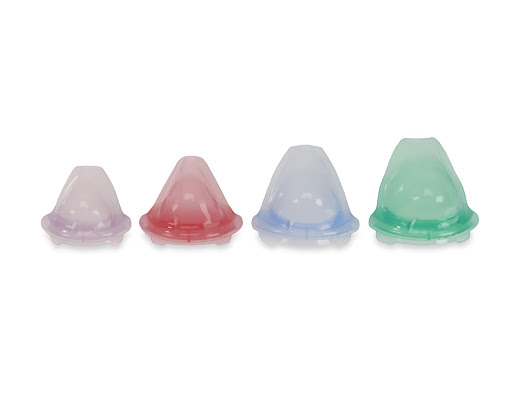
Silhouette Sizer Masks - Autoclavable
Accutron Axess:


Note: A full facemask ‘GA’ type circuit may also be used to administer the titrated gas mix. This system requires the use of an air brake connected in-line to the AGS System. In this case, no special AGS Adapter would be required. GA circuits operate in a different manner to ‘dental’ type systems, only requiring an air flow rate of 0.5 L/min.
Method of ‘Active’ Draw:
- AGSS Terminal with special AGS Adapter to allow connection to breathing system
- Connection to Chair suction port – must be a HVE (High Volume Port) as the low volume does not allow sufficient level of draw and would allow leakage of waste gases as the patient exhaled
- Miniscav – a stand alone cased pump requiring dedicated external venting

AGSS (Anaesthetic Gas Scavenging System)

Miniscav & Associated Venting Sundries

Using HVE Port on chair Suction System
Maintenance Of Equipment
- Recommended Annual O.E.M. (Original Equipment Manufacturer) Service – Ensure that the Service Provider is Manufacturer Trained/Authorised with ongoing access to spare parts and training.
- Benefit of on-site servicing – engineers can offer help and advice on the equipment usage.
- Some items of equipment such as the Miniscav have a rolling programme: Year 1 – on-site Service Check to determine performance & Year 2 Service Exchange.
- Breathing System/Masks – Once supplied, these are the responsibility of staff to inspect/care for. All components should be checked on a regular basis and replaced if showing signs of wear. Particularly the following: Reservoir bag – check ferrule neck area for holes or perishing / 8’ grey vacuum hose – pinch between finger and thumb to determine integrity – if easily compressed – replace / check inner liner flapper valve – often missing or ‘cockled’ – replace / vacuum control block – check all around for damage or missing components – replace.
Nitrous Oxide Exposure & Monitoring:
A ‘GREY’ Area – No Specific Instruction To Monitor – COSHH
(HSE Control of Substances Hazardous to Health Ed. Six 2013)
Suggested Best Practice – Annual Monitoring – Repeating if high or strange results received.

IPC Considerations:
- Autoclavable vs Disposable single patient use.
- During the covid pandemic a huge shift to disposable breathing system components; masks/tubings/connectors.
- From start of 2022 – indications of a shift back towards use of autoclavable masks and tubings.
- Vitally important to have a range of mask sizes to enable good patient fit and accommodate changes between patients.
Product Changes:
Traditionally the Porter Brown double mask; outer & liner have been solid grey. From the start of 2022, the outer mask will be clear, whilst the Autoclavable inner liner remains grey.
This is to allow observation of ‘fogging’ as the patient exhales and also allows the clinician to check the inner liner is correctly inserted.

Rev A1 - 7-2022
